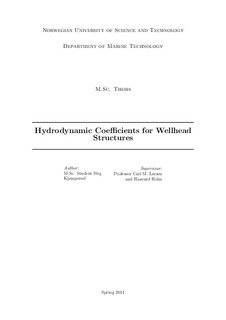| dc.description.abstract | This Master of Science Thesis is written at the Norwegian University of Science and Technology (NTNU), in Trondheim, Norway. The M.Sc. Thesis is executed during the spring of 2011. This thesis is a result of a request from FMC Technologies, Kongsberg Subsea to do research of the hydrodynamic coefficients drag and added mass. The purpose of this thesis is to find hydrodynamic coefficients for added mass and drag for a XmasTree (XT) by physical model tests and numerical calculations. A XT is a a subsea oil well valve tree, which is put on top of a well head, and used for opening and closing the oil flow from the well. During a XT life, it experience most loads during lowering through the wave zone, as can be seen in figure 1.
The XT is a complex structure, and calculation of hydrodynamic coefficients for these structures are not straight forward. Coefficients can be found by finding coefficients for each member of the structure. This method is quite uncertain, and would be inaccurate in this case due to the many members. Because of the complexity of the structure a Computional Fluid Dynamics (CFD) analysis or other numerical analysis will presumably take months. A model test is therefore the best alternative for finding these coefficients. Three different models are built to see the difference between them during these tests. One of the models is a solid box, that can be compared with theory of hydrodynamic coefficients of this sort of structure. The two other models are more similar to the XT, and have differences requested by FMC Technologies, Kongsberg Subsea (FMC). The measurements achieved during these test are scaled up to full scale values. This is possible since our models are valid as Froude models. The results are presented and compared for each parameter fixed.
In addition to the physical model tests, a numerical calculation is carried out by WAMIT. WAMIT is a computer program that is based on potential theory, and is used for analyzing floating and submerged bodies subjected to ocean waves. From this calculation we will get added mass of the models.
The calculated drag and added mass coefficient from the model tests and the numerical calulation is to be compared with theoretical hydrodynamic coefficients of this structure. | nb_NO |
